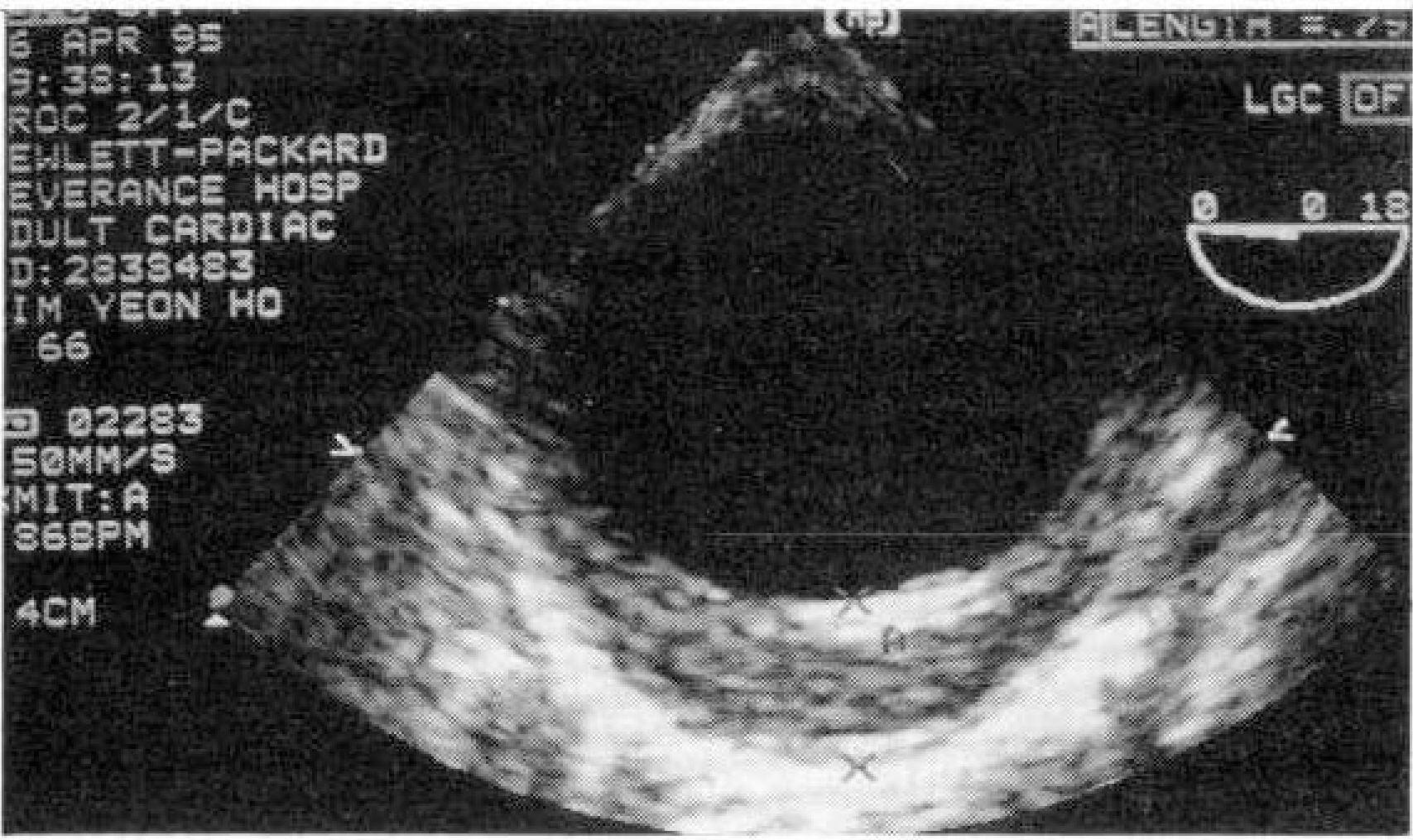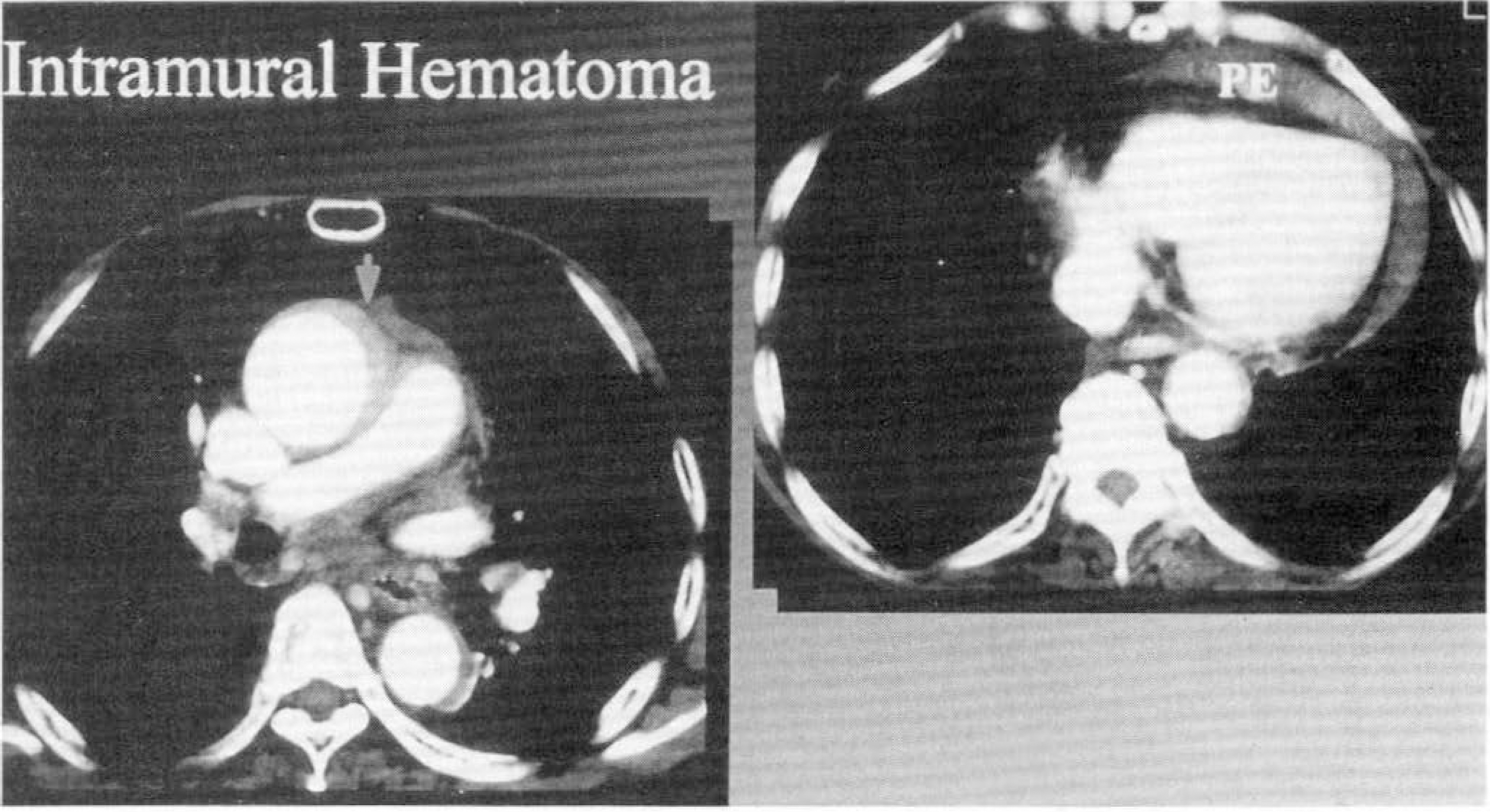J Korean Soc Echocardiogr.
1995 Dec;3(2):188-195. 10.4250/jkse.1995.3.2.188.
The Clinical Presentation and Course of Intramural Hematoma of Aorta
- Affiliations
-
- 1Cardiology Division, Department of Radiology, Yonsei Cardiovascular center, Yonsei University, Seoul, Korea.
- KMID: 2410421
- DOI: http://doi.org/10.4250/jkse.1995.3.2.188
Abstract
- Aortic intramural hematma(IMH) has been known as a variant of acute aortic dissection without intimal rupture. The clinical presentation mimics that of acute aortic dissection. IMH may progress to frank aortic dissection or aortic rupture. Therefore IMH maybe regarded as early sign of developing classic aortic dissection or a precipitating facter. there are Important two questions, The first is whether IMH truly represent a different pathology or simphy the precursor of the conventtional aortic dissection. The second is what the optimal mode of management of IMH is. In this study, To answer these questions, We retrospectively performed this study. Fifteen patients of IMH were included. We could follow 12 patients. Among them extention of IMH to type III aortic dissection has been observed in 2 cases(1 type A and 1 type B). One patients of type A underwent aortic graft stent deployment successfully. In the other patient of type B, who had a history of myocardial infarction and longstanding heart failure by that time, dissection developed at abdominal aorta with renal arterial involvement. The patient died of multiorgan failure despite intensive conservative managements. The remaining ten patients are alive with only medical care and with good clinical outcome. In conclusion we feel that conservative treatment of patients with IMH result in favorable outcome relatively even in the cases involving the ascending aorta. But more longterm follow-up of larger number of patients will provide better guidelines regarding the proper management of IMH.
MeSH Terms
Figure
Reference
-
References
1). Yamada T, Takamiya M, Natio H, et al. Diagnosis of aortic dissection without intimal rupture by x-ray computed tomography. Nippon Acta Radiol. 45:699–710. 1985.2). Yamada T, Tada S, Harada J. Aortic dissection without intimal rupture: diagnosis with MR imaging and CT. Radiology. 168:347–52. 1988.
Article3). Krukenberg E. Beitrage zur Frage des Aneurydma dissecans. Beitr Pathol Anat Allg Pathol. 67:329–51. 1920.4). Hirst AE, Johns VJ, Kime SW. Dissecting aneurysm of aorta: a review of 505 cases. Medicine(Baltimore). 37:217–79. 1958.5). Gore I. Pathogenesis of dissecting aneurysm of the aorta. Arch Pathol. 53:142–53. 1952.6). Stanson AW, Welch TJ, Ehman RL, Sheedy II PF. A variant of aortic dissection: computer tomography and magnetic resonance findings. Cardiovasc Imaging. 1:55–9. 1989.7). Takamoto S, Kyo S, Matsumura M, Hojo H, Yokote Y, Omoto R. Total visualization of thoracic dissecting aortic aneurysm by transesophageal Doppler color flow mapping(abstract). Circulation. 74(supp III):II–132. 1986.8). Zotz R, Erbel R, Meyer J. Non-communicating intramural hematoma: an indication of developing aortic dissection. J Am Soc Echocardiogra. 4:636–8. 1991.
Article9). Mohr-Kahaly S, Erbel R, Kearney P, Puth M, Meyer J. Aortic intramural hemorrhage visualized by transesophageal echocardiography: findings and prognostic implications. J Am Coll Cardiol. 23:658–664. 1994.10). Robbins RC, McMmanus RP, Mitchell RS, Latter DR, Moon MR, Olinger GN, Miller DC. Management of patients with intramural hematoma of thoracic aorta. Circulation. 88:[. (part 2):]:. 1–10. 1993.11). Robertson HF. Vascularization of the thorac aorta. Arch Pathol. 8:881–890. 1929.12). Stanson AW, Kazmier FI, Hollier Lh, Edwards WD. Penetrating atherosclerotic ulcers of the thoracic aorta: natural history and clinicopathologic correlations. Ann Vasc Surg. 1:15–9. 1986.
Article13). Christodoulos Stefanadis, Vlachopoulos Charalambos, Karayannacos Panagiotis, Boudoulas Harisios, Stratoa Costas, Filippides Theodoros, Agapitos Manolis, MD Pavlos Toutouzas MD. Effect of vasa vasorum flow on structure and function of the aorta in experimental animals. Circulation. 91:2669–2678. 1995.
Article14). Wllens SL, Malcolm JA, Vasquaz JM. Experimental infarction(medial necrosis) of the dogs aorta. Am J Pathol. 47:695–711. 1965.15). Heistad DD, Marcus ML, Law EG, Armstrong ML, Ehrhardt JC, Abboud FM. Regulation of blood flow to the aortic media in dogs. J Clin Invest. 62:133–140. 1978.
Article16). Heistad DD, Marcus ML, Martins JB. Effects of neural stimuli on blood flow through vasa vasorum in dogs. Circ Res. 45:615–620. 1979.
Article17). Hirst AE, Gore I. Is cystic medionecrosis the cause of dissecting aortic aneurysm? Circulation. 53:915–916. 1976.18). Schlatmann TJM, Becker AE. Histologic changes in the normal aging aorta: implication for dissecting aortic aneurysm. Am J Cardiol. 39:13–20. 1977.19). Braunstein H. Histochemical study of the aorta. Arch Pathol. 69:617–632. 1960.20). Erbel R, Boner N, Steller D, Brunier J, Thelen M, Pfeiffer C, Mohr-Kahaly S, Iversen S, Oelert H, Meyer J. Detection of aortic dissection by transesophageal echocardiography. Br Heart J. 58:45–51. 1987.21). Hashmoto S, Kumada T, Osakada G, et al. Assessment of transesophageal Doppler echocardiography in dissecting aortic aneurysm. J Am Coll Cardiol. 14:1253–1262. 1989.22). Tunick PA, Kronzon I. Protruding atherosclerotic plaque in the aortic arch of patients with systemic embolization: a new finding seen by transesophageal echocardiography. Am Heart J. 120:658–660. 1990.
Article23). Lanza GM, Zabalgoitia-Reyes M, Frazin L, et al. Plaque and structural characteristics of the descending thoracic aorta using transesophageal echocardiography. J Am Soc Echocardiogr. 4:19–28. 1991.
Article24). Robertson JS, Smith KV. Analysis of certain factors associated with production of experimental dissection of aortic media in relation to pathogenesis of dissecting aneurysm. J Path and Bad. 60:43–49. 1948.25). Wartman WB, Laipply TC. Fate of blood injected into arterial wall. Am J Path. 25:383–395. 1949.26). Thomas JM, Schlatmann MD, Becker Anton E. Pathogenesis of dissecting aneurysm of aorta; comparative histopathologic study of significance of medial changes. Am J Cardiol. 39:21–26. 1977.27). Mohr-Kahaly S, Erbel R, Puth M, Zotz R, Meyer J. Aortic intramural hematoma visualized by transesophageal echocardiography: follow-up and prognostic implications. Circulation. 84(supp III):II–128. Abstract. 1991.
- Full Text Links
- Actions
-
Cited
- CITED
-
- Close
- Share
- Similar articles
-
- Intramural Hematoma of the Ascending Aorta: A case report
- Aortic Intramural Hematoma Associated with Primary Aldosteronism
- Surgical Treatment of Intramural Hematoma of the Aorta: Case Report
- Pulmonary Artery Periadventitial Hematoma in a Patient with Aortic Intramural Hematoma: A Case Report
- Cardiac Tamponade and Pericarditis in Type B Intramural Hematoma: a Case Report





